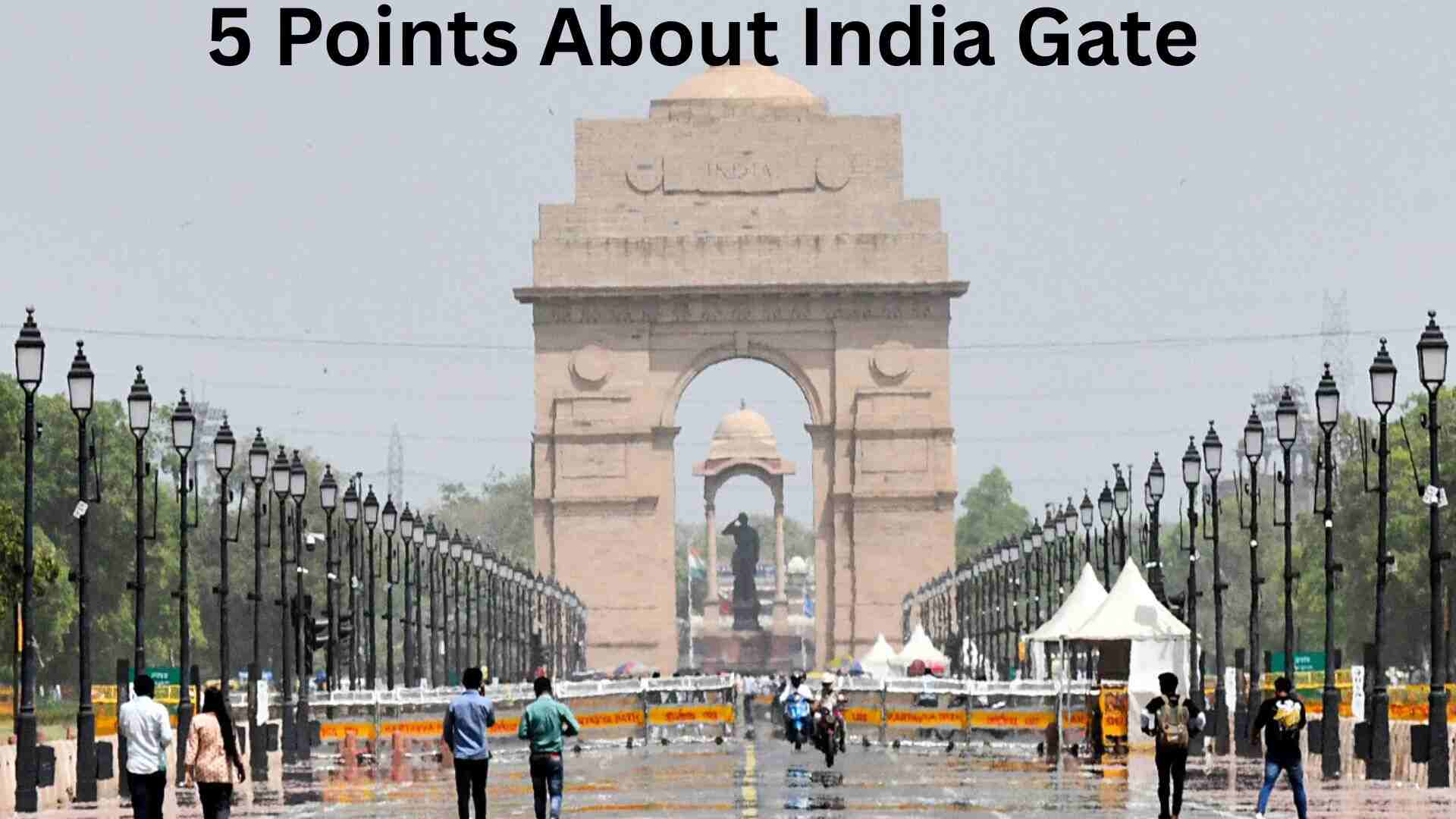5 Points About India Gate: India Gate stands as one of the most iconic and enduring symbols of the Indian Republic. Located in the ceremonial heart of New Delhi, this monumental arch is a powerful fusion of history, honor, and architecture. Originally conceived as a memorial to honor the soldiers of the British Indian Army who perished during World War I and the Third Anglo-Afghan War, India Gate has transcended its colonial origins to become a national emblem of pride and remembrance.
Towering at 42 meters, it greets every visitor with solemn dignity, its wide arc echoing the architectural legacy of classical triumphal arches. Yet beyond its form, India Gate serves as a place of quiet reflection and patriotic celebration. The lawns surrounding it often brim with life—families enjoying evenings, tourists capturing memories, and citizens gathering to honor the country’s heroes.
Over the decades, India Gate has come to symbolize not just loss, but resilience. It is a space where the past is etched in stone and the present converges in unity—a timeless reminder of sacrifice, sovereignty, and the spirit of a nation that endures. Let’s know about 5 Points About India Gate.
know about 5 Points About India Gate
India Gate is one of the most iconic landmarks in India, located in the heart of New Delhi. This historic structure attracts millions of visitors each year and holds deep national significance. Whether you’re a history enthusiast, a tourist planning to visit Delhi, or a student looking for facts, here are 5 key points about India Gate that you should know
1. Symbol of National Pride
Standing tall at the heart of New Delhi, India Gate is more than a structure; it is a monument that breathes the spirit of a nation forged through sacrifice. Every brick resonates with valor, every shadow cast across its lawn whispers history.
1.1 Architectural Grandeur Meets Historical Legacy
Modeled on the Arc de Triomphe in Paris, this massive archway is not only a marvel of early 20th-century design but also a silent narrator of India’s colonial and post-colonial journey.
2. The Design & Structure
2.1 Architectural Influences
Rooted in the triumphal Roman arches, the structure draws upon European motifs while adapting them to the Indian aesthetic milieu. The austere, clean lines reflect Lutyens’ distaste for unnecessary ornamentation.
2.2 Dimensions and Materials Used
Soaring to a height of 42 meters, India Gate is constructed using red and yellow sandstone, sourced from Bharatpur. The integrity of its form remains untouched by time, its symmetry bold against Delhi’s changing skyline.
3. Tribute to Fallen Soldiers
3.1 Names Engraved in Stone
The arch bears the etched names of over 13,000 soldiers, a haunting registry of valor, frozen in stone. Each name represents a life once lived, now immortalized on the sandstone panels.
3.2 The Role of the Indian Army in WWI
Though often eclipsed by European narratives, Indian troops played a decisive role in numerous WWI theatres—from the rugged fields of Flanders to the desolate deserts of Mesopotamia.
4. Amar Jawan Jyoti
4.1 Eternal Flame of Courage
Installed in 1972, post the Indo-Pak war of 1971, the Amar Jawan Jyoti—an eternal flame beneath the arch—burns in honor of unknown soldiers. It’s a profound symbol of collective remembrance and undying gratitude.
4.2 National Ceremonies and Honors
On Republic Day and during state visits, the nation’s leaders lay wreaths at this flame. It is here that silence roars louder than applause—a place for reverent pause.
5. India Gate as a Cultural Landmark
5.1 A Hub for Citizens and Tourists
Beyond its military connotation, India Gate is a magnet for families, joggers, and photographers. It hums with civilian life, transforming solemn history into a shared, living experience.
5.2 Art, Photography, and Public Life
Artists sketch its silhouette, couples immortalize memories beneath its arch, and street vendors animate its periphery with popsicles and trinkets.
6. Republic Day Parade
6.1 The Ceremonial Procession Route
Each year on January 26, India Gate forms the backdrop of the Republic Day Parade—a pageantry of defense might and cultural unity that courses through the Rajpath.
6.2 Showcase of India’s Military Might
Regiments march in synchrony, aircraft thunder overhead, and floats from every state converge—a synesthetic homage to India’s pluralistic identity.
7. Night-time Illumination
7.1 Lighting that Transforms the Monument
At dusk, soft lighting cloaks the structure, lending it an almost ethereal aura. The sandstone blushes under golden hues, dignifying the solemnity of what it stands for.
7.2 Evening Strolls and Public Gatherings
As Delhi winds down, India Gate awakens anew—couples stroll hand in hand, children scamper across lawns, and conversations bloom beneath the stars.
Most Read: Pondicherry Tourist Places
8. Landscaping and the Rajpath
8.1 Lush Gardens and Water Canals
Surrounding gardens offer respite amid Delhi’s bustle. Symmetrical water bodies mirror the monument, merging tranquility with stateliness.
8.2 Connecting Axis with Rashtrapati Bhavan
India Gate is part of the axial alignment that stretches from Rashtrapati Bhavan, embodying power, history, and continuum in a singular visual frame.
9. Recent Redevelopment
9.1 Central Vista Revamp
The recent redevelopment project has aimed to restore India Gate’s surroundings, introducing cleaner promenades, better lighting, and heritage-sensitive infrastructure.
9.2 Enhanced Visitor Amenities
Accessibility, security, and information panels have been augmented to enhance the visitor experience without encroaching on the sanctity of the space.
10. Conclusion
10.1 Enduring Spirit of the Indian Nation
India Gate is a hymn in stone, its arch a passage through which India’s past and present flow, entwined.
10.2 Legacy Beyond Stone and Flame
What endures is not just sandstone or script, but the ethos of sacrifice, unity, and continuity that India Gate so powerfully encapsulates.

1 thought on “5 Points About India Gate Every Indian Should Know”